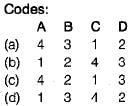Test: Soil Exploration - Civil Engineering (CE) MCQ
10 Questions MCQ Test - Test: Soil Exploration
Consider the following statements:
1. The soil obtained from wash boring is a representative sample.
2. Recovery ratio will be high during drilling in sound rock.
3. Hollow stem augers are sometimes used to. drill holes in silty sand.
Which of these statements is/are correct?
1. The soil obtained from wash boring is a representative sample.
2. Recovery ratio will be high during drilling in sound rock.
3. Hollow stem augers are sometimes used to. drill holes in silty sand.
Which of these statements is/are correct?
Consider the following statements:
On addition of lime to swelling soils,
1. their liquid limit increases
2. their plastic limit increases
3. their shrinkage limit increases
4. their swelling potential decreases
Which of these statements are correct?
On addition of lime to swelling soils,
1. their liquid limit increases
2. their plastic limit increases
3. their shrinkage limit increases
4. their swelling potential decreases
Which of these statements are correct?
During a sampling operation, the drive sampler is advanced 600 mm and the length of the sample recovered is 525 mm. What is the recovery ratio of the sample?
Match List-I (Unit) with List-ll (Purpose) and select the correct answer using the codes given below the lists:
List-I
A. Graded filter
B. Lime treatment
C. Impervious clay core
D. Curtain grouting
List-ll
1. To reduce seepage of water through body of earth dam
2. To reduce water seepage through foundation below dam
3. To stabilize black cotton soils
4. To drain water without losing fines from the soil

Match List-I (Type of exploration) with List-ll (Soil profile) and select the correct answer using the codes given below the lists:
List-I
A. Diamond core drilling
B. Uncased wash boring
C. Open pit excavation
D. Cased boring
List-ll
1. Medium strong cohesive soils
2. Rocky formation
3. Soft cohesive soils and cohesionless soils. Exploration up to relatively large depths
4. Exploration up to a shallow depth below ground level

The correct sequence of the increasing order of the disturbance to soil samples obtained from chunk, piston, split spoon and remoulded sampler is
A soil sampler has inner and outer radii of 25 mm and 30 mm, respectively. The area ratio of the sampler is
Which technique of stabilization for sub base is preferred for heavy plastic soils?
Mechanical stabilization of the soil is done with the help of


















